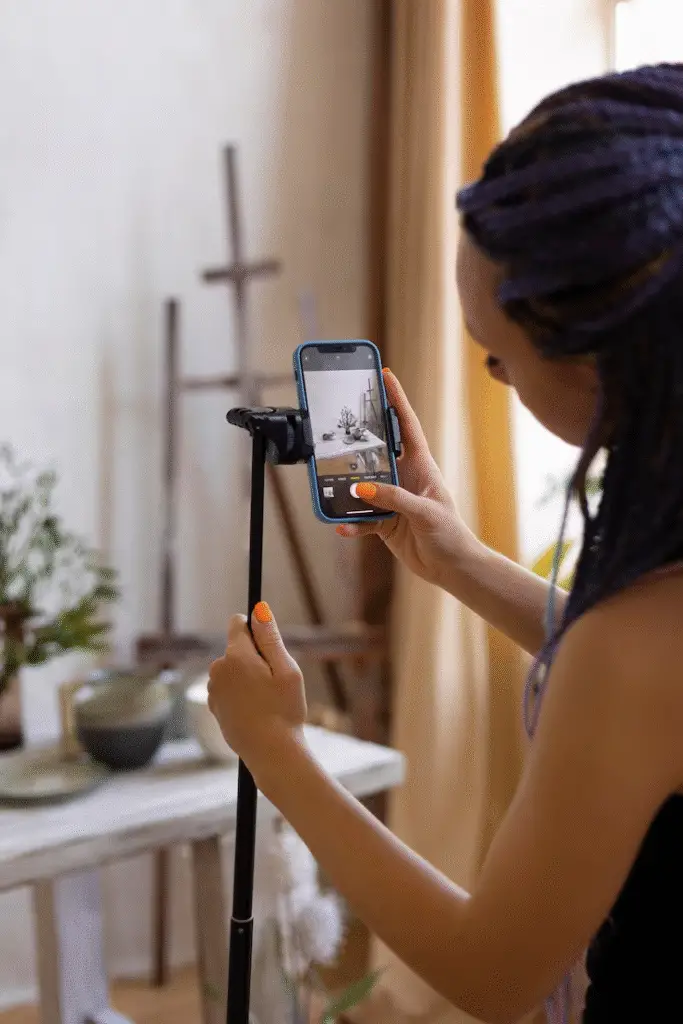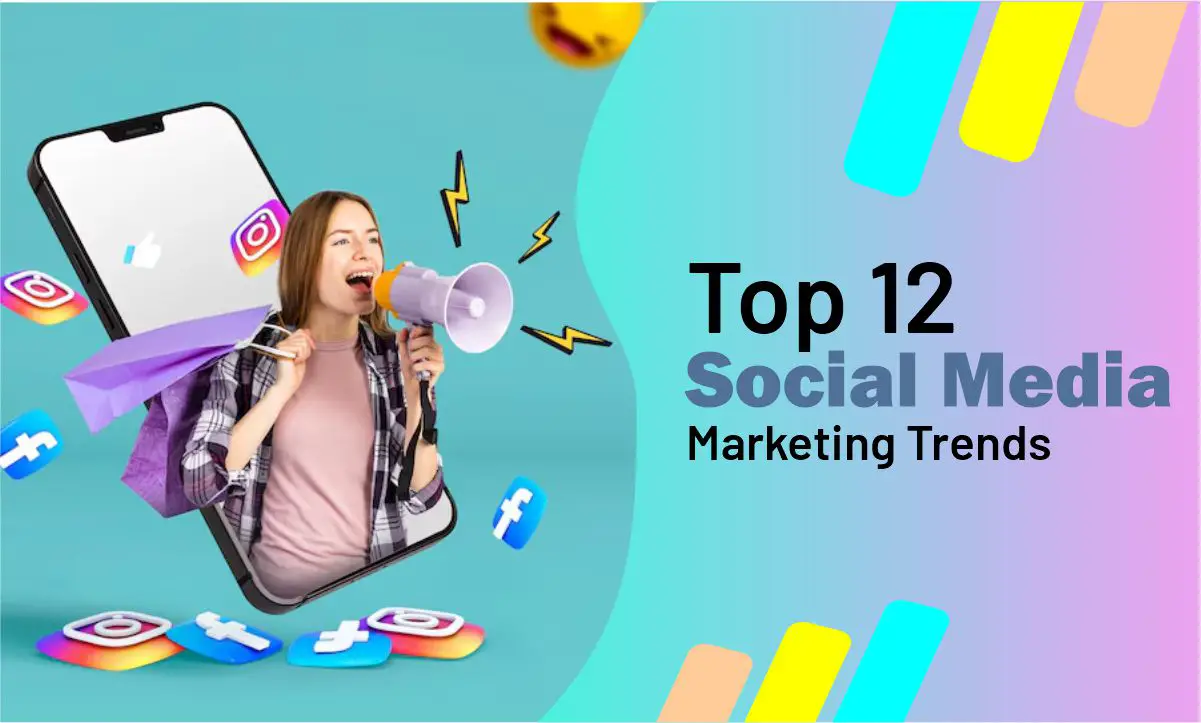Social media in 2025 is not just evolving—it’s transforming the very foundation of digital communication, branding, and commerce. For SaaS companies, DTC brands, influencers, and marketing professionals, the pace of innovation demands both adaptability and foresight. From hyper-personalized AI tools to immersive augmented reality experiences, the digital landscape is being redrawn with each passing quarter. To stay relevant, brands must not only understand these changes but actively integrate them into their strategies.
This guide highlights the top four transformative trends shaping the social media space, with in-depth insights, real-world examples, and strategic recommendations.
Trend 1: AI Tools That Think and Create Like Your In-House Team

Artificial Intelligence has moved beyond simple automation to become an integral creative force within marketing teams. The AI tools of 2025 are capable of emulating brand voice, predicting content success, designing visuals, scheduling across platforms, and even interacting with audiences in real time. These tools do more than just streamline work—they elevate creative possibilities.
Key Developments:
- Generative AI with Brand Intelligence: Tools now offer custom training models that learn your brand’s voice, tone, visual identity, and past performance to produce hyper-relevant and on-brand content.
- Predictive Analytics: AI analyzes engagement history and seasonal trends to suggest topics, formats, and even publishing times likely to maximize impact.
- Multimodal Capabilities: Platforms like Midjourney 7.0 and Adobe Firefly enable simultaneous image, video, and copy creation within a single ecosystem.
Notable Examples:
- Midjourney v7.0: This latest release allows users to train the AI on specific brand aesthetics. From product photography to campaign visuals, the AI outputs consistent designs that align with brand guidelines across global campaigns.
- Meta AI Studio: Companies like Sephora are using Meta’s AI Studio to build virtual customer service avatars. These AI personas answer queries, recommend products, and maintain brand tone across Messenger, Instagram, and Threads.
- Zara’s AI Campaigns: By applying advanced style-transfer algorithms, Zara blended runway photography with artistic effects that mirror their seasonal aesthetics. The result? A viral campaign with 5x higher engagement.
Why This Matters:
AI-powered content creation is leveling the playing field. Startups with minimal budgets now produce content rivaling major brands in quality and consistency. The shift has made originality and strategic storytelling more important than budget.
Moreover, AI-driven responsiveness enables brands to ride viral trends in real time—turning around campaigns in hours, not weeks. This agility boosts engagement and relevance, especially among Gen Z and younger millennial audiences who value timeliness and cultural fluency.
Trend 2: Rise of the Micro-Community Ecosystem

As major platforms like Facebook and X become increasingly crowded and algorithmically unpredictable, brands are turning to micro-communities—digital enclaves that foster deeper connection and brand advocacy. These spaces, often hosted on platforms like Circle, Geneva, Discord, or custom apps, prioritize quality engagement over mass visibility.
Micro-Community Characteristics:
- Exclusive Access: Membership tiers, gated content, and invite-only groups create a sense of belonging.
- High Intent Engagement: Conversations in micro-communities are more targeted, with discussions around specific pain points, lifestyles, or interests.
- Actionable Feedback Loops: Members often become brand co-creators, offering insights on product design, pricing, and positioning.
Notable Examples:
- Circle’s Tiered Monetization: Fitness influencers and wellness brands use Circle to deliver premium content, community chats, and direct coaching. Members pay monthly fees, providing a recurring revenue stream while fostering loyalty.
- Glow Recipe’s “Glow Gang“: This ambassador-led skincare community encourages content creation and feedback. In return, members get exclusive access and recognition. The result? UGC that performs 3x better than paid ads.
- Gucci’s Elite Platform: Gucci created a luxury, members-only digital lounge where top-tier customers preview new drops, chat with designers, and receive curated style advice. Repeat purchases and average order value have skyrocketed.
Why This Matters:
Micro-communities aren’t just engagement channels—they’re brand fortresses. Unlike mainstream social platforms, these spaces aren’t at the mercy of ever-changing algorithms. They give brands ownership over their customer relationships, reduce churn, and provide a goldmine of qualitative data.
Strategically, marketers should use public platforms for discovery and awareness, then guide their most loyal fans into private spaces where deeper engagement, monetization, and co-creation can occur.
Trend 3: The Vertical Video Standard Takes Over

The days of 16:9 content being the default are gone. In 2025, vertical video (9:16) is not just a mobile-first format; it’s the industry standard. Driven by TikTok, Instagram Reels, YouTube Shorts, and Snap Spotlight, vertical content has evolved into its own cinematic language.
Core Attributes of Vertical Content Today:
- Pacing & Editing: Videos feature fast cuts, punchy intros, and attention-grabbing visuals in the first 3 seconds.
- Text as a Storytelling Tool: On-screen text conveys messages silently, addressing the reality that over 85% of users watch without sound.
- Optimized for Swipe Culture: Videos are short, looped, and algorithmically positioned to capture thumb-stopping attention.
Notable Examples:
- YouTube Shorts: With 70 billion daily views and over 2 billion active users, Shorts has become YouTube’s fastest-growing feature, often outperforming traditional videos in reach.
- Adobe’s Vertical Video Academy: Offers deep dives into editing vertical video for maximum engagement, including data-backed techniques for retention and conversion.
- Reuters Vertical Newsroom: Traditional outlets are now building vertical-first production teams to reach mobile-first audiences, adapting international stories into quick, digestible visual formats.
Why This Matters:
Social content now lives in vertical spaces. This isn’t a trend—it’s the new normal. With over 93% of social consumption happening on mobile, brands must design stories for tiny screens and distracted viewers.
From influencer collaborations to product demos, vertical-first thinking boosts visibility, completion rates, and shares. Even advertisers are reporting 2-3x lower CPAs on vertical creative compared to traditional formats.
Trend 4: Augmented Reality (AR) Shopping Redefines Social Commerce

Social commerce is entering a new phase with immersive, AR-powered try-on features that eliminate friction in the buying process. This technology has matured significantly, delivering real-time interactivity and realism that boosts buyer confidence.
Features Driving the Trend:
- Facial and Body Mapping: Accurate, responsive overlays that mimic real-world product behavior.
- Environmental Simulation: Products can be previewed in a user’s room or on their body in real scale and proportion.
- Integrated Checkout: Shoppers can view, try, and buy without leaving the social app.
Notable Examples:
- Warby Parker’s IG AR Integration: Leveraging Meta’s AR tools, Warby Parker allows users to virtually try glasses. This tool cut return rates by 40% and significantly boosted first-time conversions.
- IKEA’s Spatial AR Tool: Their app now integrates with social platforms, using room-scanning tech to show products with 93% dimensional accuracy. Customers can visualize entire room layouts before purchase.
- Sephora’s AR Makeup Studio: Users can test hundreds of shades on their faces through Instagram filters, transitioning from discovery to purchase in one seamless session.
Why This Matters:
AR shopping solves e-commerce’s biggest pain point: uncertainty. By simulating the in-store experience, brands build trust, reduce returns, and increase conversion rates. As attention spans shorten and patience for site redirects wanes, keeping the shopping journey within the social app is a game changer.
In 2025, AR is no longer an experimental feature. It’s a core sales driver. Brands that integrate AR into their campaigns see higher dwell times, richer engagement, and a more informed, satisfied customer base.
Trend 5: The Rise of Authentic Imperfection in Digital Creation

Social media has undergone a seismic shift—what once celebrated hyper-curated perfection now rewards raw honesty. Gone are the days when every photo had to be flawless, filtered, and aspirational. Today’s creators are intentionally sharing content that’s imperfect, messy, and wonderfully real. This isn’t just a stylistic preference; it’s a deeper response to a growing cultural fatigue with inauthenticity.
Consumers, especially younger generations, have become more media literate. They understand the tricks of editing, lighting, and digital enhancement—and they’re actively pushing back. Content that feels “too polished” is increasingly perceived as disingenuous. Instead, creators are leaning into transparency, showing behind-the-scenes chaos, embracing unfiltered moments, and highlighting flaws that once would have been edited out.
Examples of Authentic Imperfection in Action:
- #NoFilter as a Movement: Once just a simple tag to show an unedited photo, #NoFilter has transformed into a broader philosophy. It now represents a mindset that values real skin, real moments, and raw storytelling over aesthetic perfection. Engagement with #NoFilter posts is surging across platforms like Instagram and TikTok, especially among Gen Z audiences seeking deeper emotional resonance.
- Emma Chamberlain’s Cultural Shift: Emma didn’t just post unfiltered photos—she revolutionized how creators talk to their audience. Her YouTube vlogs, marked by abrupt jump cuts, awkward silences, and candid monologues, broke the mold. Instead of pretending to be put-together, she shared her anxiety, insecurities, and everyday chaos—earning trust and loyalty from millions.
- Skin-Positivity Pioneers Like Hyram Yarbro: Known for his brutally honest skincare advice, Hyram gained traction not by showing flawless skin, but by normalizing texture, acne, and redness. His transparency about lighting, filters, and product effectiveness has made him one of the most trusted voices in the beauty world, with data showing his “real skin” content drives 3.2x more engagement.
Why It Matters:
This trend signals a profound change in the creator-audience relationship. 76% of Gen Z and Millennials now report they are more likely to trust and engage with creators—and brands—who showcase real, imperfect content. On the flip side, perceived inauthenticity is actively penalized through unfollows, negative comments, and low engagement.
For brands, this is a wake-up call: High production value alone isn’t enough. Audiences crave relatability and vulnerability. The brands winning today are those that strike a balance—maintaining visual quality while allowing their human side to shine through. Think candid behind-the-scenes moments, unscripted reactions, and content that feels more like a friend’s update than a polished campaign.
Trend 6: The Emergence of Short-Form Audio as a Key Content Format

As the demand for passive content consumption grows, short-form audio has stepped into the spotlight as an efficient, intimate, and versatile medium. These compact sound bites—typically between 30 and 99 seconds—offer a valuable alternative to video and text, especially in moments when users are multitasking.
Unlike traditional podcasts, which often demand extended attention spans, short-form audio fits neatly into fragmented moments throughout the day: during commutes, workouts, meal prep, or even shower routines. With the rise of voice-first technologies like smart speakers, earbuds, and AI voice assistants, audio is no longer a background feature—it’s a core content experience.
Examples of Short-Form Audio Success:
- Spotify’s “Minute of Music”: Artists now release 60-second audio previews to tease their upcoming tracks. These micro-previews have proven highly effective at boosting pre-release anticipation and increasing full-song stream rates upon launch.
- NYT’s “60-Second Daily Briefings”: The New York Times packages the day’s top stories into bite-sized audio summaries, optimized for morning routines. Their 2024 Digital Report revealed 528.6 million daily listeners tuning in—most of whom listen during non-visual moments like commuting or making breakfast.
- Clubhouse’s “Clips” Feature: To extend the reach of its long-form discussions, Clubhouse allows users to create and share 60-second highlights. These snippets drive cross-platform discovery and foster virality by giving users digestible previews of longer conversations.
Why It Matters:
Short-form audio is carving out a critical space in the content ecosystem. It fills the usability gap between text (which requires focus) and video (which demands visual attention). For time-constrained users, especially millennials and busy professionals, audio snippets deliver valuable content with minimal friction.
From a brand perspective, audio storytelling builds emotional intimacy that written words often lack. Completion rates are also higher for short audio than for longer formats, making it an efficient channel for delivering messages. The intimacy of voice—tone, pacing, emotion—makes these snippets more impactful, especially for brand storytelling, quick tips, or motivational content.
Trend 7: Social Media as the New Learning Hub

In a significant shift, social platforms have transformed from time-fillers to skill-builders. Educational content now dominates user preferences, with billions turning to TikTok, YouTube, Instagram, and LinkedIn to learn everything from cooking to coding. Users no longer scroll just to be entertained—they want to leave smarter, even in small ways.
This evolution is fueled by creators blending education with entertainment, creating snackable, engaging content that doesn’t feel like a lecture. Storytelling, strong visuals, and personality are now key to knowledge-sharing online. Platforms are responding by investing in new formats and algorithms that prioritize educational value.
Examples of Education Going Viral:
- #LearnOnTikTok’s Meteoric Growth: What began as a TikTok initiative now boasts over 500 billion views. Internal platform data shows that users who engage with learning content spend 43% more time on the app and report 62% higher satisfaction—proof that knowledge, when packaged right, retains users.
- Emily Mariko’s “Basics Series”: Her clean, minimalist cooking tutorials teach kitchen fundamentals in a calm, structured style. The result? 12.4 million followers and 87% completion rates—extraordinary for any video content.
- Khan Academy’s “Concept in 60 Seconds”: These ultra-brief lessons introduce core concepts and drive users to in-depth courses. Since launching across social platforms, Khan Academy reports a 230% increase in traffic to their long-form learning programs.
Why It Matters:
Educational content builds credibility and trust for creators—and offers incredible brand lift for companies that provide real value. It turns passive scrolling into productive discovery and fosters stronger creator-audience relationships.
For brands, offering micro-educational content is a golden opportunity. It creates utility-driven engagement: instead of just promoting a product, you’re solving problems and teaching something valuable. Educational content is also sticky—users return to pages that regularly teach them something useful, driving up retention and loyalty.
Trend 8: Privacy-First Platforms and the Trust Recalibration
In the wake of growing data breaches, algorithmic manipulation, and digital surveillance, users are rethinking their relationship with social media. Trust, once taken for granted, is now a core differentiator. A new breed of privacy-first platforms is rising to meet this demand—offering transparency, control, and autonomy as their foundational principles.
This is about more than regulatory compliance. It’s about a new user expectation: that platforms will protect privacy proactively, not just when mandated to. Features like decentralized architecture, local data storage, no-tracking policies, and granular privacy settings are becoming selling points—not just afterthoughts.
Examples of the Privacy-First Wave:
- Mastodon’s Federated Future: With over 15 million users across thousands of independently governed instances, Mastodon champions decentralization and user autonomy. Surveys show 72% of its users cite the lack of algorithmic control and targeted ads as reasons for joining.
- Meta’s New Privacy Center: In a notable pivot, Meta consolidated its privacy settings into a centralized, easy-to-understand interface. While still recovering from past trust issues, this move signals a strategic shift toward greater transparency.
- Signal’s Expansion into Communities: Initially known for secure messaging, Signal now offers community spaces with the same end-to-end encryption. Its adoption by legal, medical, and journalistic professionals reflects growing demand for privacy-respecting social interaction.
Why It Matters:
This is the beginning of a new digital social contract. Users are no longer passive participants—they are demanding clarity, consent, and control over how their data is used. Brands and platforms that fail to offer this risk irrelevance.
For marketers, this means a rebalancing act. Hyper-targeted ads based on behavioral tracking are being replaced by content strategies focused on contextual relevance and value alignment. Opt-in relationships, permission-based data collection, and honest communication now drive performance more than tracking pixels ever could.
Brands that prioritize user trust—by being transparent, respectful, and privacy-aware—are laying the groundwork for deeper, more sustainable engagement. In the long run, that trust isn’t just good ethics—it’s good business.
Trend 9: The Decline of “Post Everywhere” Strategies and the Rise of Platform-Native Content
The Era of Platform Awareness
The once-popular “post everywhere” strategy—where brands share identical content across all platforms—has steadily lost its effectiveness. In 2025, the landscape of digital engagement demands tailored content experiences, not blanket reposting. The fragmentation of social audiences has created unique ecosystems on each platform, each with its own culture, algorithms, and user expectations. As a result, high-performing brands are evolving toward integrated, channel-specific strategies that respect the nuances of each platform while reinforcing a consistent brand identity.
What Works Now
Rather than treating social platforms as identical distribution points, today’s best marketers see them as distinct stages of the customer journey—each channel plays a specialized role. Broad-reach platforms like TikTok drive brand awareness with viral, bite-sized entertainment. Instagram fosters community and aspirational identity, while LinkedIn may serve for thought leadership and professional alignment. YouTube offers deeper education and storytelling, and owned platforms (like apps or websites) close the loop on conversion and loyalty.
🔍 Case Study 1: Peloton’s Multi-Touchpoint Strategy
Peloton doesn’t repurpose a workout clip across five platforms. Instead, it creates content that plays to the strengths of each platform:
- TikTok is used for viral challenges that drive mass awareness.
- Instagram features behind-the-scenes content, instructor spotlights, and motivational stories.
- YouTube offers full class previews and deep dives into the Peloton ecosystem.
- Peloton’s own app delivers the core product experience, tying it all together.
This orchestration reduces acquisition costs and amplifies loyalty by aligning content with consumer expectations at each stage of interaction.
🔍 Case Study 2: Salesforce’s Platform Personality Guide
Salesforce built a “Platform Personality Guide”, which outlines how the brand voice should adapt across channels.
- On LinkedIn, it emphasizes industry authority and innovation.
- On Twitter (X), it embraces timely conversations and customer shoutouts.
- On YouTube, it focuses on explainer videos, partner success stories, and product demos.
- On TikTok, it shifts to humor, employee voices, and bite-sized educational content.
This granular approach has led to measurable increases in engagement, especially as audiences appreciate context-aware content.
Why It Matters
Audiences no longer follow brands across platforms—they encounter them where they already are. This makes it essential for brands to speak the “native language” of each platform, both visually and tonally. Moreover, consistent presence across diverse environments builds credibility, trust, and recall.
Studies indicate that brands seen across 3+ platforms within a week have a 58% higher consideration rate, largely due to the “cross-platform reinforcement effect,” where familiarity breeds trust through repetition and relevance.
Trend 10: Why Value-Driven Content Is Outperforming Product Promotion
From Greenwashing to Green Proof
In 2025, sustainability isn’t just a bonus—it’s a baseline expectation. Consumers no longer accept vague promises or feel-good statements. They expect data-backed action, tangible results, and stories that reflect a brand’s long-term environmental and social commitment. More importantly, they want to participate in that impact.
The Shift in Storytelling
Brands that lead in engagement aren’t pushing eco-products—they’re pulling audiences into shared purpose. Effective sustainability stories now include behind-the-scenes transparency, impact metrics, and narratives that invite consumer involvement.
🔍 Case Study 1: Patagonia’s #WornWear Circular Economy
Patagonia’s sustainability efforts go far beyond messaging. Its #WornWear initiative promotes gear repair, not just sales.
- On TikTok, DIY repair tutorials have surpassed 50 million views.
- Over 125,000 garments were repaired through the program in the past year.
- Consumers actively share their repair stories, turning sustainability into a community behavior rather than a corporate campaign.
🔍 Case Study 2: Lush and Ingredient Transparency
Lush is redefining product storytelling by following the life cycle of ingredients.
- On Instagram and YouTube, Lush shares content about how cocoa butter is sourced from fair trade cooperatives.
- These ingredient-centric stories outperform standard product posts by 3.2x in terms of engagement.
- Consumers are more likely to try products when they trust the process behind them.
🔍 Case Study 3: Unilever’s “Small Actions” Movement
Unilever encourages consumers to become co-creators in sustainability with the #SmallActions campaign.
- Users submit personal eco-friendly habits, from switching to bamboo toothbrushes to minimizing food waste.
- The campaign has seen over 780,000 user submissions, with clear sales lifts in its green product lines.
- The sense of collective movement reinforces both emotional connection and behavioral change.
Why It Matters
Purpose-driven content connects with people on a values level, not just a practical one. When audiences identify with a brand’s mission, loyalty skyrockets. In fact, 64% of consumers are more loyal to brands they believe share their values.
Additionally, transparent sustainability storytelling builds long-term credibility and makes it harder for competitors to replicate success—because it’s rooted in real actions, not just good copywriting.
Trend 11: Interactive Content That Invites Co-Creation
Passive Scrolling Is Dead—Participation Is In
The social media era is moving from broadcast to collaboration. The most engaging content in 2025 isn’t just meant to be watched—it’s meant to be touched, voted on, stitched, remixed, or co-created. From simple engagements like polls and sliders to fully-fledged AR experiences, brands are giving audiences the tools to contribute and personalize.
Participation = Psychological Investment
When users become part of the content, they develop a sense of ownership—and that changes everything. They’re more likely to share it, remember it, and form emotional ties to the brand.
🔍 Case Study 1: National Geographic’s Global Storytelling via Instagram
Through Instagram’s collaborative story feature, NatGeo invites photographers around the world to contribute to ongoing visual documentaries in real-time.
- This participatory content achieves 4.7x higher completion rates than standard Stories.
- It creates a feeling of global community, where users don’t just watch—they witness and interact.
🔍 Case Study 2: Gymshark’s TikTok Dance Collaborations
Gymshark uses TikTok’s Duet and Stitch features to host massive choreography challenges.
- Dancers worldwide collaborate with trainers and celebrities.
- Result: viral visibility, brand consistency, and authentic UGC across markets.
🔍 Case Study 3: Fenty Beauty’s AR-Powered #FentyFaceChallenge
Using AR, Fenty lets users try on makeup looks and then post their own versions.
- Each participant becomes a model for the brand, helping others visualize results.
- This boosted product discovery while generating a massive library of tutorials with real people.
Why It Matters
Interactive content generates 4-5x higher engagement rates, but more than that—it produces valuable first-party data. Every quiz, slider, poll, or remix gives brands direct insight into consumer preferences, enabling smarter segmentation and personalization.
And perhaps most critically, participation = memorable experience. In a noisy content landscape, what people do sticks far more than what they passively see.
Trend 12: The Rise of Real-Time, Ephemeral Content That Creates Urgency
Synchronous Moments in an Asynchronous World
In a world where content is always available, temporarily available content has new power. Real-time and ephemeral formats—think livestreams, flash drops, timed events—are creating urgency, cultural relevance, and habit loops among social media users.
These moments tap into the psychological phenomenon of FOMO (fear of missing out) and encourage immediate interaction, helping brands stand out in crowded feeds.
🔍 Case Study 1: BeReal’s Authentic Brand Windows
BeReal’s real-time prompts have evolved into a space for spontaneous brand engagement.
- Brands that respond within the 2-minute window see 5.2x higher engagement.
- The raw, unedited nature builds authenticity and trust, especially among Gen Z.
🔍 Case Study 2: Chipotle’s Live “Kitchen Cam” Series
During peak lunch hours, Chipotle streams behind-the-scenes kitchen action for 30-minute windows.
- The transparency builds credibility and curiosity.
- The campaign led to a 34% spike in same-day orders during broadcast hours.
🔍 Case Study 3: Supreme’s 24-Hour Drop Model on Social
Supreme adapted its legendary in-store “drop” culture to social platforms.
- Each drop disappears after 24 hours.
- On average, they draw 2M+ concurrent viewers, building anticipation and exclusivity.
Why It Matters
Real-time experiences prompt immediate action and boost platform stickiness. Users who engage in real-time content check back 3.2x more frequently in subsequent days, often forming habits around brand content.
Moreover, the social conversation around these shared moments amplifies their reach, making them not just events, but cultural moments.
For marketers, this means developing nimble teams capable of jumping on live trends, and balancing predictability (scheduled events) with delightful surprises.
Charting Your 2025 Social Media Roadmap: What Winning Brands Are Doing Differently
Social media in 2025 is no longer just about broadcasting content—it’s about building ecosystems of trust, participation, and relevance. Audiences today crave more than just pretty visuals or clever captions. They want to connect with brands that show up consistently, speak authentically, and create experiences that feel personal and valuable.
The landscape has shifted away from generic, passive strategies. Simply repurposing the same content across every platform is no longer effective. Instead, the brands that thrive are those that treat social media as a dynamic conversation—one where the audience is not just a viewer, but a collaborator, critic, and co-creator.
What do audiences want now?
They’re looking for transparency over polish, dialogue over monologue, and content that educates, inspires, or involves them. They expect platforms to respect their time, attention, and privacy. And they resonate with brands that stand for something—whether it’s sustainability, inclusion, or innovation.
Feeling overwhelmed? That’s normal—but here’s how to move forward:
You don’t need to jump on every trend right away. What matters most is alignment. Start by identifying the trends that genuinely fit your brand’s identity and your audience’s behaviors. Test these ideas on a small scale, gather data, and listen to feedback. Then double down on what works, and fine-tune the rest.
Social media success in 2025 isn’t about doing everything—it’s about doing the right things with purpose, clarity, and consistency.
Your next step? Pick one trend that resonates, experiment with intention, and let your audience guide the evolution.
Conclusion: Winning in the Social-First Era
The social media landscape of 2025 rewards brands that embrace creativity, agility, and deep community-building. AI is no longer just a tool—it’s a collaborator. Micro-communities aren’t fringe spaces—they’re essential brand ecosystems. Vertical video is not optional—it’s the primary format. AR shopping isn’t a novelty—it’s the new checkout aisle.
To thrive in this environment, marketers must:
- Invest in AI tools that align with their creative workflows.
- Build private community spaces to strengthen customer loyalty.
- Produce native vertical content across all platforms.
- Integrate immersive, interactive features that eliminate buyer friction.
The future belongs to brands that don’t just adapt but lead these innovations. Now is the time to reimagine what your social media presence can be—because in 2025, social isn’t just a marketing channel; it’s the heartbeat of the customer experience.

